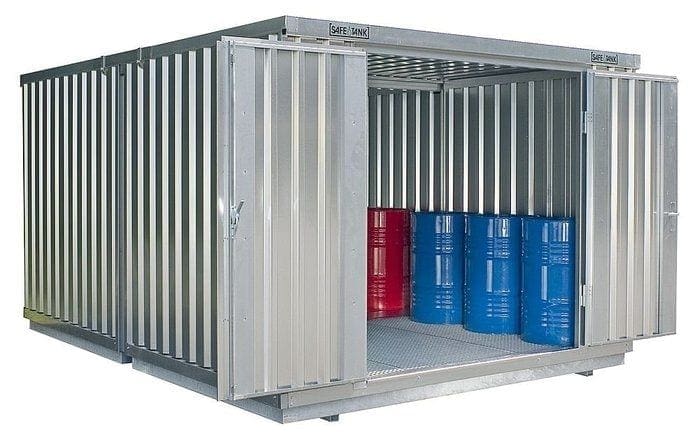
How to Customize and Convert Steel Storage Containers for Creative Uses
Steel storage containers are typically used for shipping and storing goods, but their robustness, durability, and modular design make them excellent candidates for a variety of creative conversions. From cozy homes and trendy cafes to innovative office spaces and art studios, the possibilities are virtually endless. In this blog, we’ll explore how you can customize and convert steel storage containers for various innovative uses, providing practical tips and inspirational ideas along the way.
Understanding the Basics of Steel Container Conversion
Converting a steel storage container into a functional and stylish space involves more than just aesthetic changes. It requires a thoughtful approach to maintaining structural integrity, ensuring proper insulation, installing necessary utilities, and complying with local regulations. Each of these elements plays a crucial role in transforming a basic steel box into a livable and workable environment.
Before diving into specific projects, it’s important to understand the basic considerations involved in converting a steel storage container. These include:
Structural Integrity
Steel containers are designed to be incredibly durable and to carry heavy loads. However, their structural integrity can be compromised when they are modified. Cutting large openings for windows, doors, or removing sides affects the strength of the steel frame. To counteract this, it’s essential to reinforce these areas with additional steel beams or framing to ensure the container can withstand these alterations without any risk of collapse or deformation. This step is critical, especially in areas prone to extreme weather conditions or where the container will support additional weight, such as a green roof.
Insulation
Insulation is another key aspect of converting a steel container. By nature, metal conducts heat, which means that containers can become very hot in summer or cold in winter if not properly insulated. Effective insulation helps to create a comfortable interior climate and reduces energy costs associated with heating and cooling. Common insulation choices include spray foam, which adheres to the interior walls and provides an excellent thermal barrier, and rigid foam panels that are easy to install. The choice of insulation often depends on the climate of the area and the intended use of the container.

Utility Installation
Installing utilities such as electricity, plumbing, and HVAC systems is often necessary to make a converted container fully functional. This process usually requires professional installation to ensure safety and efficiency. Electrical wiring must be protected and properly installed to prevent hazards. Plumbing needs to be thoughtfully designed to maximize space and maintain functionality. HVAC systems must be sized correctly for the space to efficiently regulate temperature. Proper planning and execution of these systems are essential for creating a space that is not only comfortable but also compliant with safety standards.
Permitting and Regulations
Before starting any conversion project, it’s important to understand and comply with local building codes and zoning regulations. These can vary significantly depending on the location. Obtaining the necessary permits can be a complex process, involving detailed plans and specifications of the proposed conversion. In some areas, containers are considered temporary structures and face different regulations than permanent buildings. Engaging with local planning offices early in the project can help to avoid legal complications and ensure that the conversion meets all required legal standards.
Converting a steel storage container into a habitable space involves careful consideration of structural adjustments, insulation, utilities, and regulatory compliance. Each of these aspects requires thoughtful planning and, often, professional assistance to ensure that the conversion is safe, efficient, and legally compliant. By addressing these fundamental elements, you can transform a simple container into a durable, comfortable, and functional space that meets your specific needs.
Creative Uses and Customization Ideas
Container Homes
One of the most popular uses of steel containers is in building affordable and stylish homes. Here’s how you can customize a container for residential use:
- Windows and Doors: Adding large windows and glass doors not only brings in natural light but also helps the container feel more spacious.
- Interior Walls: For larger homes using multiple containers, interior walls may be necessary. These can be constructed from lightweight materials to create separate rooms.
- Roofing: Consider adding a roof garden or a simple pitched roof for better water drainage and additional insulation.


Pop-Up Retail Stores and Cafes
Steel containers are perfect for pop-up shops and cafes due to their portability and ease of modification. To convert a container for this use:
- Openings: Larger openings can be cut out for serving windows or fold-out doors, which can double as awnings during business hours.
- Aesthetics: Use bright paints, wood cladding, or even artistic murals to make the exterior eye-catching.
- Compact Design: Optimize the interior space with custom-built furniture and modular installations that can be easily moved or reconfigured.
Portable Offices
Converting a container into a portable office is a cost-effective solution for businesses needing additional space. Customize your office container by:
- Partitioning: Create separate workspaces inside the container using lightweight partitions.
- Connectivity: Ensure that you have adequate provisions for internet and phone lines, vital for any modern office.
- Ergonomics: Incorporate ergonomic furniture and adequate lighting to create a comfortable working environment.
Art Studios and Workshops
Containers can be converted into personal art studios or workshops, offering a secluded space to work on creative projects:
- Natural Light: Install skylights or large windows to provide plenty of natural light, essential for any artist.
- Storage Solutions: Utilize the vertical space for storage with shelves and wall-mounted containers to keep supplies organized.
- Durable Flooring: Install durable and easy-to-clean flooring such as laminate or polished concrete to handle spills and stains from art materials.


Cost-Effectiveness of Steel Storage Containers
Steel storage containers are increasingly recognized not only for their durability and flexibility but also for their cost-effectiveness. As both individuals and businesses look for affordable solutions for extra space, these containers have become popular due to their relatively low expense compared to traditional building materials and methods. Below, we explore the various factors that contribute to the cost-effectiveness of using steel storage containers for various projects.
Initial Purchase and Setup Costs
Steel containers are readily available and can be purchased used or new from suppliers around the world. The cost of a used container typically ranges from a few thousand dollars, making it an economical choice compared to the cost of constructing a building from scratch. Additionally, the initial purchase price often includes the basic structure of the container, which already has floors, walls, and a roof. This means the primary shell of your project is already in place, which significantly reduces the initial phase of construction costs.
Speed of Construction
One of the most significant cost-saving aspects of using steel containers is the speed of transformation. A container can be converted into a functional space in a fraction of the time it takes to build a traditional structure. Since much of the container can be pre-fitted or modified offsite, on-site construction time and costs are greatly reduced. This also means labor costs are lower, and for commercial projects, it allows for a quicker return on investment as the space can be operational in a shorter time frame.
Durability and Maintenance
The inherent durability of steel containers leads to lower long-term maintenance costs. Made to withstand harsh conditions during ocean transport, these containers are robust, weather-resistant, and less susceptible to problems like termites and rot, which commonly affect wooden structures. The longevity of steel also means that it requires less frequent repairs or replacements compared to other materials, contributing further to the cost-effectiveness of the investment.



Energy Efficiency and Insulation
Although metal is a conductor of heat, modern insulation techniques can transform a steel container into an energy-efficient space. The right insulation not only makes a container habitable but can also reduce ongoing energy costs. With the addition of green technologies such as solar panels, which are easily installed on the flat roofs of containers, owners can further decrease operational costs and even generate their own energy.
Repurposing and Resale Value
Steel containers can be repurposed multiple times for different needs, which adds to their cost-effectiveness. A container that initially serves as a construction site office can later be converted into a storage space, a retail outlet, or a residential home. Each adaptation can be done with relatively minimal expense compared to building anew. Furthermore, if the container is no longer needed, it retains a resale value in the used container market, providing an exit strategy that recoups some of the initial investment.
Steel storage containers offer a versatile, cost-effective, and sustainable option for various custom projects. Whether you’re looking to build a home, start a pop-up business, or craft a personal creative space, these containers can be transformed to fit nearly any requirement. With some creativity, proper planning, and attention to detail, your steel container project can become a functional, stylish, and environmentally friendly space that stands out.
